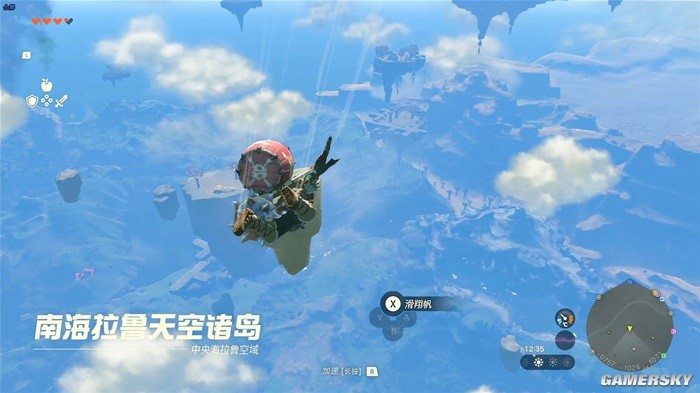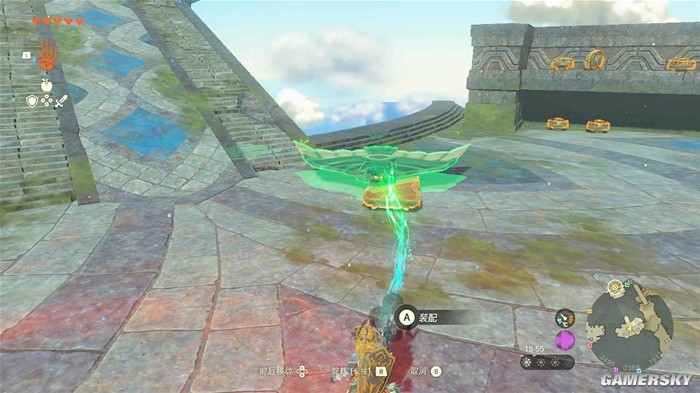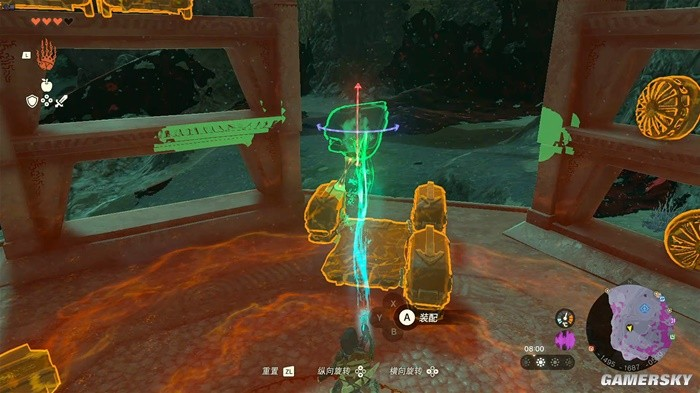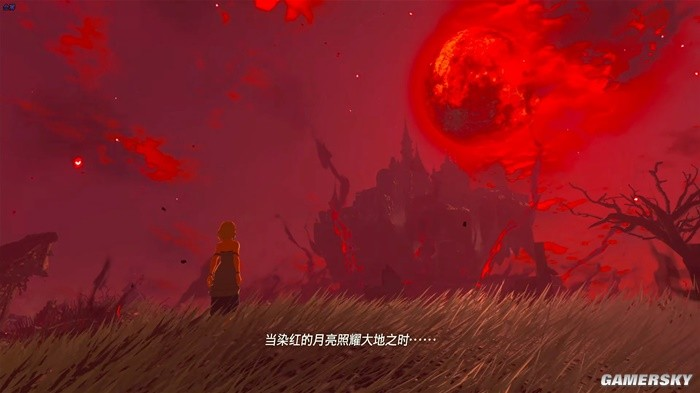- Published on
The Legend of Zelda: Tears of the Kingdom
- Authors

- Name
- BSG
- @nextjser
- The Legend of Zelda: Tears of the Kingdom Review
- A Triple-Decker Mega World
- Equipped with the official superpower Mod
- Tears of Regret
- Conclusion
The Legend of Zelda: Tears of the Kingdom Review
I can't remember the last time I looked up from the screen to find the sun rising, but I can confidently say that The Legend of Zelda: Tears of the Kingdom is one of those games that keeps you hooked until the early hours. No one could tear me away today; I must declare: Tears of the Kingdom is peerless.
I naively thought that Tears of the Kingdom would be a Plus version of Breath of the Wild. I was wrong. It surpasses its predecessor in every dimension, including gameplay, story, playability, and content volume. It's like a giant standing on the shoulders of another giant, lifting players into a dreamlike sky, where the descent takes ages.

If you've played Breath of the Wild, experiencing Tears of the Kingdom feels like a brain upgrade, leaping from the Stone Age to the Industrial Revolution in seconds. Players can now pass through "solid walls" overhead, reaching mountains that once took minutes to climb in just a few seconds; recover materials accidentally dropped into pits with time reversal; and use shields with spotlights to blind enemies, creating flying mechs with guided missiles and flamethrowers to storm monster camps. Everything I played in Breath of the Wild feels like child's play now. The times have truly changed.
A Triple-Decker Mega World
Tears of the Kingdom's world is divided into three layers: sky, ground, and underground. Although the content and scale of the sky and underground areas are clearly different from the ground map, it's safe to say that this game offers at least twice the content of its predecessor.
The sky is where players arrive first, primarily used to unlock parts for assembly, obtain some Sheikah energy, and specific enemy drops. The useful cooking resources on the sky islands are plentiful, with stamina wheat more than enough. Exploring a few sky islands provides enough resources to fly from one corner of the Hyrule continent to the other.

The overall layout of the ground map is similar to its predecessor, with temples still scattered across the land, but most have moved. Due to the "heaven and earth mutation," the terrain of many areas has changed significantly. For example, the lava of Death Mountain has disappeared entirely, revealing a wealth of interesting new locations.

The underground is a different story. It's a vast black void the size of the entire Hyrule continent, filled with life-eating miasma and more ferocious monsters, more dangerous and rewarding than elsewhere. Powerful throwables like Smokeshrooms and Chaos Flowers can be obtained here, and minerals and battery upgrade items needed for blueprint construction are also found underground.
Thus, the sky, ground, and underground are not separate maps; they are seamlessly interconnected, and the resources obtained from them form a meaningful cycle. Energy obtained in the sky, plants that dispel miasma, and luminous seeds obtained on the ground can aid exploration underground. Batteries and minerals obtained from the underground can also expand the breadth of exploration on the ground and in the sky.
I really appreciate the improved guidance in Tears of the Kingdom. Perhaps it's because I liked to run around and not follow the guide in Breath of the Wild, which led to quite a few difficulties. In Tears of the Kingdom, I find that I can always keep up with the game's guidance—thanks to the "surveillance fortress," a kind of bonfire shrine from the Dark Souls series. Whenever I encounter an impassable obstacle, asking Purah and Jozu for help always yields answers, reducing the negative experiences caused by weak guidance.

For example, I believe many people in this game will do what I did: unlock all the bird watchtowers on the map first, and then conveniently fly from the launched high altitude to the vicinity of another region's bird watchtower. But even though I used the air "jump" to open all the maps first, almost all of them were done in a straight line, without missing any key props or stories. I even explored the surrounding sky islands and discovered an underground mineral vein because of a dragon flying towards the underground.
When playing Breath of the Wild, most of the time I was wandering aimlessly, after all, apart from the four divine beasts, there were no other really important things. But in the world of Tears of the Kingdom, I always have something to do, always have a clear goal driving me, even so many things that I will simultaneously advance several. It wasn't until a task I picked up halfway was completed that I realized I had long forgotten why I set out.
The design of the main line temples in this work also satisfies me very much. It is no longer a narrow box that can reverse gravity, but a truly themed large-scale puzzle level, returning to the feeling of the box garden design in previous works. The Temple of Fire is the most ingenious level I think in the entire game, using mine cars and various track switching devices to reach some hard-to-find corners, while understanding the abilities of the heroes and breaking through various seemingly impossible angle barriers. This kind of gradual mastery of new abilities through level design has indeed come back.
My personal preference for game teaching philosophy is not to describe what will happen to players after doing this with text alone, but to let players take the initiative to "try it," or to subtly demonstrate to players through the environment and props. For example, when I first came to the underground from the sky island, I found it difficult to find a suitable takeoff point for the flight wings in the sky island on the ground. Until I met a Boss, the vehicle he escaped on gave me the answer: as long as you put a flat panel with wheels under the wings. In fact, real airplanes have landing gear, but when you are immersed in the logic of the game, you often overlook this point.

There are many constructions and combinations that I did not understand by myself, but learned from observing the environment, the combinations made by the enemies, and even some of the machinery in the temple. It can be said that the whole world of Tears of the Kingdom is like a textbook on "how to play Tears of the Kingdom".
Equipped with the official superpower Mod
It's about time to talk about the ability design of this work. To be honest, I think any ability in this work can be taken out alone, such as the Ultimate Hand, Scrap Construction, and Time Reversal, and can be used as the theme of a creative game. But the most powerful part of Tears of the Kingdom is that it is all implemented under such a super large open world system of "Hyrule Continent", just like the official launched a powerful enhanced version Mod for Breath of the Wild, and redesigned a large number of high-quality levels and puzzles for it.
"Ultimate Hand" is essentially a magnet with an assembly function, but the freedom of the assembly ability is unprecedentedly high. Players can basically assemble all movable objects together, including but not limited to weapons, various environmental props, and even the stones in the temple can be taken out. The game also provides a lot of prefabricated parts in the Sheikah Capsule, which can easily assemble the desired functions and effects.

I also enjoy the assembly process very much, and many constructions come from a casual glance on the road. Whenever I find something with an interesting structure, I start thinking: can these things be combined? I have never found my creative desire so strong, because the effect of such free construction is really amazing.
Matched with the Ultimate Hand is the "Blueprint" function. This is not an initial ability, but an exploration task that needs to be completed underground to unlock. Blueprints can be said to be the most powerful ability in the entire game, because it can not only assemble the existing materials together. It can also create something out of nothing, reproduce the things you have combined before (but it requires the consumption of ore). Whether it is a self-propelled cart equipped with various weapons, a board that can float in the air at any time with a rocket, or even the various climbing structures that have been combined in the temple can be taken down as they are. I always save two large stone slabs in my blueprints, and when I encounter something, I can directly build a long bridge.
"Scrap Construction" ability is another tool that allows players to freely exercise their creativity. All the props that can be combined with the Ultimate Hand in the above text can also become the materials for the equipment in your hand. You can install a spring on the shield, bounce back the enemy's attack, and use the shield action to directly make a boost big jump. You can also install a ruby on the sword tip to create a simple wand that launches fireballs. You can even install a faucet on the boomerang, and throw it out to purify a large area of sludge ground - I passed the part of Zora territory full of sludge in this way.
At the same time, Scrap Construction also cleverly solved another problem in Breath of the Wild: weapon durability. I believe more than one person has been tortured by the weapon durability of the wild blow, and a backpack full of treasures can be broken after fighting a monster camp. But in Tears of the Kingdom, every time you kill a monster and combine the materials it drops, it is equivalent to having a new weapon.
And "Reverse the Universe" and "Sky Clim bing" are the biggest help in the exploration process. To be honest, there is nothing to talk about these two abilities, because the effect is on the surface: one is simply a time reversal, making objects return along the original track. The other can directly let you cross any entity overhead, and drill from the ground to the ground.
Although these abilities have simple effects, I have never seen any open world game that really gives these abilities almost unlimited to players to use at will. The openness of all these abilities combined is also unprecedentedly high. Many puzzles no longer need to use the props given by the level, and players can plan how to move from Point A to Point B at will - because the game gives players the freedom to do so. The designer uses scattered parts, inclined platforms, suspended bricks and other ways to hint to the players, just like a half-written draft. But how to turn this draft into an actual action blueprint depends entirely on the player's own creativity.
In Tears of the Kingdom, I often complete the goal in a way that is divorced from reality. The most satisfying thing is that I used the "left foot right foot" method on the sky island, and hung around the air to drill into a door that needs ten hearts to open. It could have stopped me, but Nintendo did not. Perhaps this is their reward for players who are motivated and can use all tools to achieve this. It is much more fulfilling than actually collecting ten hearts and then opening the door.
But on second thought, this must also be within Nintendo's expectations. The efforts they have made behind the scenes to allow players to use these abilities smoothly must also be quite great. As we all know, games involving construction and combination, as well as time reversal and wall penetration abilities, are all high-incidence areas of bugs. Nintendo not only installed them all in one game, but also let me pass through the process without encountering any obvious bugs.
Tears of Regret
Of course, Tears of the Kingdom is not without regrets.
One is the regret of the plot connection with the previous work. After the "heaven and earth mutation" in this work, the world has changed completely, but the game does not explain the changes of the Sheikah civilization and various ruins in the previous work, including the whereabouts of the various Guardians and the Four Divine Beasts. Although there are some hints and clues in the game, I still hope that the official can give a clear plot explanation, rather than cleverly avoiding the doubts generated by the players about the plot. (Of course, it can also be understood as a parallel world)

Compared with the numerous tasks on the ground and in the sky island, the exploration underground is more free, opportunities and dangers coexist, bringing a completely different experience. But the overall feeling of the underground is still very "empty". Most areas are empty, the density of interest points is much lower than the ground, and there are a lot of fillers that have to be collected for upgrading (spirit, ore, etc.). As a result, the exploration experience of the underground part outside the mainline task cannot be compared with the ground and sky island.
Since we are talking about the underground, I also have some complaints about the difficulty of upgrading and resource acquisition in the early stage of the game. The upgrade of battery capacity and the amount of various materials obtained in the early stage are relatively fixed. If the player just goes where they go, instead of going to brush energy, ore, and battery with a specific purpose. Then it is likely to find that when trying to build various devices and combinations, resources are always not enough.
In other words, the proportion of repetitive work such as brushing materials or mining in Tears of the Kingdom is higher. Of course, considering that this is a game that can support hundreds of hours of play, it does need to set some thresholds, but it also makes the early exploration a bit constrained.
Another point to mention is the design of the four heroes' skills, which are not only not as good as the previous work in terms of functionality, but also the triggering method is very unreasonable - it must be triggered by the player walking next to the hero for interaction. During the mainline temple puzzle, I often had to start over because the teammates were not cooperating in their positioning. When I carried all the heroes out, whenever I wanted to start a certain hero's ability accurately, I had to pick in the crowd for a long time, which was very troublesome. And the plot line of the four heroes in this work also seems a bit insignificant, and even the interstitial animation of obtaining the hero's blessing is a long repetition.
Conclusion
I will not say that Tears of the Kingdom is a perfect game, but it is indeed a game that is enjoyable from beginning to end, with a truly "fun" core experience. It has some regrets, but it still cannot cover up its excellent comprehensive experience in many dimensions, and the rich design concept that leads the industry.
No matter what the evaluation standard is, I will think that Tears of the Kingdom is a full score game. The experience it brings is too unique and rare, just like a thunder in the desert of electronic games, leaving a long aftershock. Now I have only one question: Tears of the Kingdom has successfully surpassed the peak created by Breath of the Wild, so how should the next Legend of Zelda cross the difficult mountain of Tears of the Kingdom?